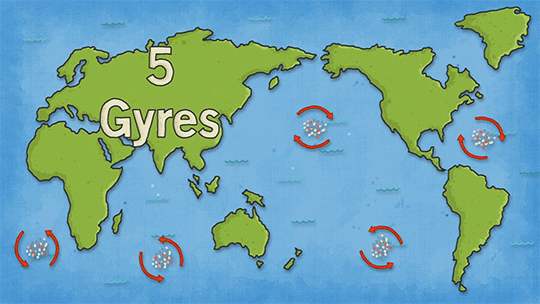
Plastic Pollution Is Destroying The World
Plastic as we know it has only really existed for the last 60-70 years, but in that time it has transformed everything from clothing, cooking and catering, to product design, engineering and retailing. One of the great advantages of many types of plastic is that they're designed to last - for a very long time. And nearly all the plastic ever created still exists in some form today.

Less than a fifth of all plastic is recycled globally.
Single-use-plastics frequently do not make it to a landfill or are recycled. 25 million tons of plastic packaging produced annually is left to flow into our oceans; the equivalent of pouring one garbage truck of plastic into the ocean every minute.
Plastic waste accumulates in areas of the ocean where winds create swirling circular currents, known as gyres, which suck in any floating debris.
Half a million straws are used in the world every day.

Single-Use Plastic has become a part of our daily lives
Polyethylene terephthalate (PET)
Water bottles, dispensing containers, biscuit trays


High—density polyethylene (HDPE)
Shampoo bottles, milk bottles, freezer bags, ice cream containers
Low—density polyethylene (LDPE)
Bags, trays, containers, food packaging film
Polypropylene (PP)
Potato chip bags, microwave dishes, ice cream tubs, bottle caps
Polystyrene (PS)
Cutlery, plates, cups
Expanded polystyrene (EPS)
Protective packaging, hot drink cups
Plastic in the Ocean
Even if you live hundreds of miles from the coast, the plastic you throw away could make its way into the sea. Once in the ocean, plastic decomposes very slowly, breaking down in to tiny pieces known as micro plastics that can be incredibly damaging to sea life. 80% of plastic in our oceans is from land sources – but what does that really mean? Where is it coming from?
There are three main ways the plastic we use every day ends up in the oceans.
-
Throwing plastic in the bin when it could be recycled:
-
Plastic you put in the bin ends up in landfill. When rubbish is being transported to landfill, plastic is often blown away because it’s so lightweight. From there, it can eventually clutter around drains and enter rivers and the sea this way.
-
-
Littering:
-
Litter dropped on the street doesn’t stay there. Rainwater and wind carries plastic waste into streams and rivers, and through drains. Drains lead to the ocean! Careless and improper waste disposal is also a big contributor – illegal dumping of waste adds greatly to the plastic surge in our seas.
-
-
Products that go down the drain
-
Many of the products we use daily are flushed down toilets, including wet wipes, cotton buds and sanitary products. Microfibres are even released into waterways when we wash our clothes in the washing machine. They are too small to be filtered out by waste water plants and end up being consumed by small marine species, eventually even ending up in our food chain.
-
Once in the ocean, the plastic accumulates in 5 areas around the world
Ocean currents concentrate plastic in five areas in the world: the subtropical gyres, also known as the world’s "ocean garbage patches". Once in these patches, the plastic will not go away by itself.


